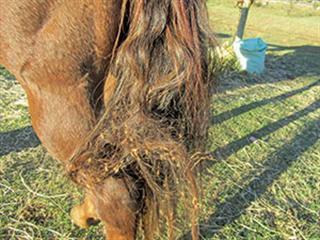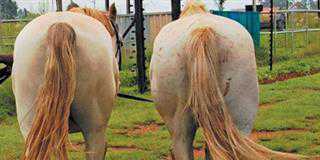
Burrs are the spiny seed pods of several plant species. The most common genus in South Africa is the South American invader Xanthium, also known as the ‘Bathurst bush’ or ‘boetebossie’. Like the khakibos, it was probably imported to South Africa in the manes and tails of horses brought in from Argentina during the Second Anglo-Boer War. This annual plant likes nitrogen-rich soils enriched with horse manure and can grow up to 1,2m high. It’s grey-green in colour, with three-lobed leaves and spiny two-pronged thorns.
As Xanthium dies and dries out at the beginning of winter, the stems and burrs attach to the manes and tails of grazing horses. In show horses, this can result in the loss of chunks of mane or tail hair that might have taken years to grow.
But burrs are not simply unsightly, they can also prove a health hazard to a horse.
Once they are stuck in the mane or tail, more and more hair becomes entangled around them. Finally, the spiny burrs prick the skin and stimulate the horse to rub them off, eventually causing painful wounds that can become infected.Although these are not perennial plants, they spread rapidly because the seed pods (the burrs) attach to passing animals and are distributed far and wide.
Eradication of plants and removal of burrs
It is not only the burrs that are a threat; the entire plant is. Young Xanthium plants are toxic to livestock and the spines can cause skin infections. These are declared weeds and should be removed immediately if spotted on your farm. When removing burrs from a horse’s coat, collect and burn them rather than simply throwing them onto the manure heap, where they can grow.
Patience is required to remove burrs. Separate one strand of hair at a time from the clump of tangled hair and burrs, using a hoof pick to avoid being pricked. Brush the burrs out of the single strand and pull it to one side. Then separate out another strand and repeat the procedure. If burrs have been in the mane or tail for a week or more, you may have to cut out the matted tangles. Once the mane or tail is cleaned, plait it to avoid the problem from re-occurring.
When farm horses are not seen daily, prevent burrs attaching by keeping the forelock short (maximum 3cm), cutting excess hair behind the fetlocks, hogging the mane and cutting the tail hair level with the hocks, ‘military style’.
Contact Dr Mac at [email protected]. Please state “Horse talk” in the subject line of your email.












